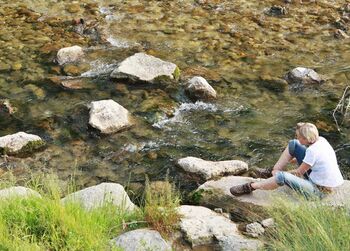Pielach valley
Location in Austria
About 50 kilometers away from Vienna, the capital of Austria, Pielach valley, with its diverse landscapes at the foothills of the alps, is an attractive spot to visit. The Pielach is one of Austria’s purest alpine rivers and stages a number of picturesque pools for a refreshing swim. The Pielach river winds alongside the famous Mariazeller railway, a nostalgic narrow-gaged railway track.
We consider our region as an important part of real Austria.
Eden Destination
The Pielachtal, a valley in the Alpine foothills of federal state of Lower Austria, was selected as the winner from among the twenty-four entries. In the Pielachtal, culture, nature, way of life, handicrafts and specialty foods are combined to form a network of innovative offers.
The Dirndl (pl. Dirndln), or Cornel (Dogwood), popularly known as a cherry, although it is in fact a very old and healthful species of its own, is cultivated as the valley’s “trademark”.
The Dirndl is presented as a tourism attraction and introduced to guests in a manner at once entertaining and educational. With initiatives for gentle mobility, co-operative projects joining together agriculture, handicrafts and tourism, as well as a sustainability report that is nationally unique,the Pielachtal succeeded to demonstrate that it deserved the title of Austria’s best emerging rural destination.
The Pielachtal is located in the Mostviertel region of the province of Lower Austria. The Mariazellerbahn railroad runs through the valley connecting the provincial capital St. Pölten and Mariazell.
Approximately 17,000 people live in the Pielachtal. The Pielachtal is known for its beautiful landscape, as well as its exemplary sustainable development.
In Pielachtal (=Dirndltal) sustainability is a tradition. Farming shaped the life of the valley in the past and continues to do so today. Human activity revolved around cattle, chicken and sheep, herbs and fruits, in particular the most typical fruit of the area, the cider pear.
The idea for the Pielachtal Eco-Region began to take form in 1994. “Eco” stands for both ecology and economy. The aim is an ecologically intact and economically prosperous region for work, leisure and recreation.
In addition to ecology and economy, social networking and cultural resources were stressed.
A multitude of cultural projects was initiated, including the “Pielachtal Artists Days”, regular performances of folk music at inns, and a cooperative venture with the director of the Vienna Boys Choir.
Integrated tourism ensures the support and encouragement of the local population to get involved in tourism offers.
“In the heart of nature’s plenty, in the heart of Pielachtal life” is the motto that inspires offers affording an authentic insight into the valley’s nature, culture, crafts and way of life.
Sustainability defines not only the character of offers, but is also a theme that they communicate.
Guests are invited to learn to “read” the landscape and discover the interrelationships between nature and agriculture. They have the opportunity to learn about the principles and advantages of sustainable horticulture and the processing of fruits and herbs. There is a great variety of paths and gardens that invite guests to undertake discovery tours. The total length of the region’s hiking paths is over 1,000 kilometres.
There is a variety of gardens: the lovingly cultivated and tended natural landscape, gardens of local people, and the Steinschaler gardens. Qualified guides impart interesting facts about
hiking, caves and nature as well.
Gentle mobility is the central theme suggested by the Mariazellerbahn: hikers in particular enjoy travelling by train for at least part of their trip.
An additional motivation to travel by train is the “Steinschalerhof Soft Mobility Package”, which earned the International Nets Award in Berlin.
Therefore the Pielachtal region is distinguished, amongst others, by the following:
- Transfer potential: The region’s sustainability report is unique in Austria, and by virtue of its high transfer potential can serve as an example for other destinations.
- Health – theme of the future: As part of regional development efforts, academic analysis and development of the health theme is being carried out based on medical studies. The focus of the product being designed is the treatment of metabolic disorders.
- Health and ecology: It was possible to document the interaction of health and ecology – “Garden of Sustainability” – which has great potential for the development of a USP.
- Integrative tourism: Exemplary cross-sector co-operation between firms in the tourism branch, agriculture, trade, and local associations.
Two extraordinary vacation hotels have been created in the area:



